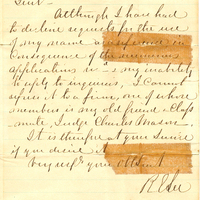The “Bridge between the State, the University and the Northern Virginia Area”: Charles R. Fenwick, Virginia Lawmaker and A Founder of George Mason College
Charles R. Fenwick, a Virginia state senator representing Arlington County, helped create the Fairfax campus of George Mason College. While serving as Rector of the University of Virginia between 1964 and 1966, he was a principal member of the George Mason College (GMC) Advisory Committee. Today, Fenwick is recognized as one of George Mason University’s founders. Throughout the 1950s and 1960s, he was committed to funding the construction of buildings that would establish GMC in Northern Virginia.[1] While Fenwick set out to find support for these projects, he may have felt an ever-closer affinity with the college’s namesake.
In 1861, Senator Charles Fenwick’s grandfather, R. W. Fenwick, started his Washington, DC, patent law firm with a Mr. Charles Mason. Soon after the Civil War, the practice represented clients as Mason, Fenwick & Lawrence, with offices on F Street, N.W., Washington DC. The legal team was the second oldest patent firm in the country and they built a wide network of clients and supporters across the country and by 1908 their self published 47th anniversary book boasted the firm had twelve offices accross the country. The third partner was DeWitt Laurence. [2]
In the 20th century, professional associations with Mason men benefited Charles R. Fenwick. He was a prominent patent attorney who walked the halls of power, where he rubbed shoulders with fellow graduates of the University of Virginia Law School. He earned his JD degree in 1925. His career as a Democratic senator and senior lawyer in Mason, Fenwick & Mason of Washington, DC, (the firm dropped Laurence and added another Mason) introduced Charles Fenwick to the movers and shakers of Virginia Governor Byrd’s regime. After challenging Byrd in a 1953 run for the gubernatorial seat, Fenwick became a loyalist of the formidable “Byrd Machine.”[4]
[1] Letter, Arthur Arundel, Arlington, to Dr. Lorin Thompson, George Mason College, Fairfax, July 10, 1967; Northern Virginia Sun, Dec. 16, 1967; University Libraries, Special Collections, C. Harrison Mann Collection, Box 75, Folder 9; Washington Post, Feb. 23, 1969.
[2] William Boyd, Boyd’s Directory of Washington, Georgetown, and Alexandria, Together with Compendium of their Governments, Institutions and Trades (Washington, DC: William H. Boyd, 1870), 263; Washington Post, Feb. 23, 1969; Robert E. Lee to Mason, Fenwick and Lawrence, 6 July 1869, Washington and Lee University Library Special Collections, Robert E. Lee Papers; Mason, Fenwick and Lawrence Patent and Trade-Mark Lawyers, Patents For Profit: Forty Seventh Anniversery Booklet, (Washington D.C.: Mason, Fenwick, and Lawrence, 1908).
[4] Washington Post, May 10, 1953; Peter Henriques, “The Byrd Organization Crushes a Liberal Challenge, 1950-1953,” The Virginia Magazine of History and Biography 87, 1 (1979), 27-28; James Sweeny, “Revolt in Virginia: Harry Byrd and the 1952 Presidential Run,” The Virginia Magazine of History and Biography 86, 2 (1978), 185.
Kyle Filter


